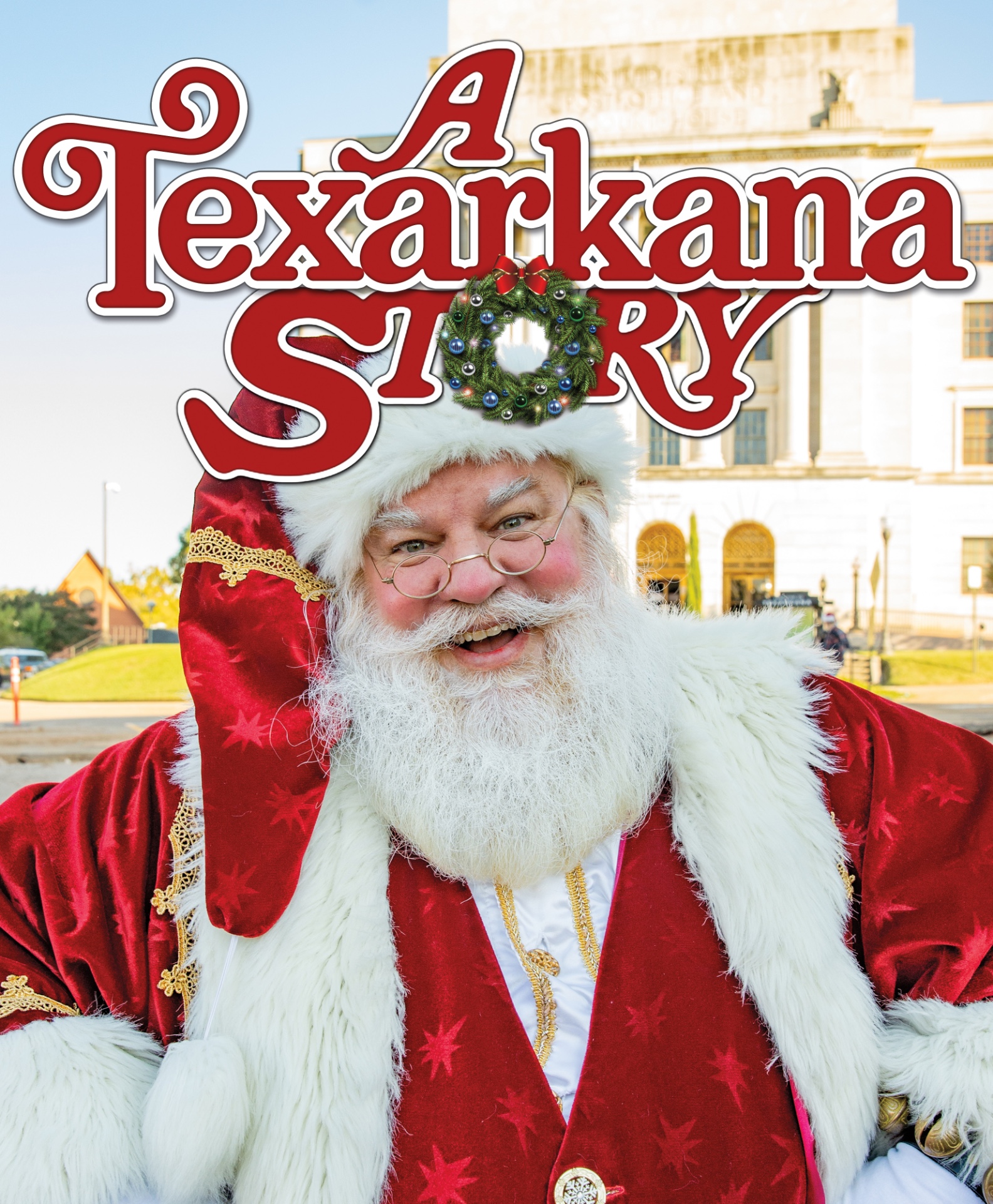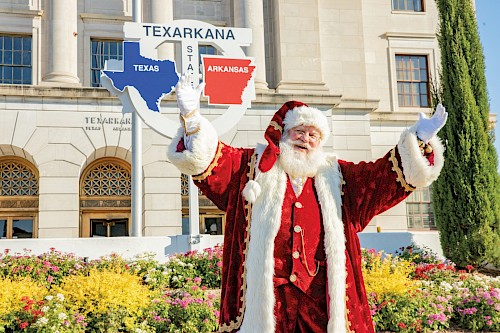A Texarkana Story

This month’s issue of Texarkana Monthly is a sentimental look into the history of Texarkana. These twin cities have been deeply enriched by so many people with fascinating stories, traditions, and resources. We are taking the opportunity this holiday season to reflect on where we came from, who we are, and where we are going. So much of our incredible past is completely unknown to most of the community, but it’s a history that is worth knowing and passing on to the next generation of Texarkana residents.
There is something so magical about the month of December.
Many consider December 8, 1873, to be the date our city was formally established. On that historical day, the first selling of town lots took place. Local historian, Dr. Beverly Rowe, explains in her book Historic Texarkana-An Illustrated History, that “Men from all over the region rode onto the site and camped out in order to be there on December 8, when the sale of town lots began. One of the first purchases made was by J.W. Davis. He is said to have purchased the lot where the Hotel McCartney was later built and still stands today, across from Union Station.”
“The establishment of Texarkana, Arkansas, and Texarkana, Texas, was more the result of national railroad expansion than it was the actions of the earliest settlers,” writes Dr. Rowe. Texarkana’s early economy was built on timber, wood products, cotton and rail transportation. By way of the railroad industry, the Texarkana area served as a gateway to the Southwest. It wasn’t long after the Civil War ended that “The establishment of Texarkana as a ‘railroad town’ was a story repeated across the nation in other towns by the hundreds, if not thousands.” Today, whether you are in downtown Texarkana or on the outskirts of town, you can see our foundation in the winding railways that trail through our city.
Word quickly traveled about the abundance of job opportunities in Texarkana. Dr. Rowe states, “The predominantly male population of the city in its earliest years spawned gambling houses, barrooms, and brothels.” A cheeky mural depicting the “ladies of the night” of that era can still be found on Spruce Street. According to Dr. Rowe, “Texarkana’s rough and tumble beginnings certainly created a rich field of work for religious denominations and their preachers.” As mentioned in the Gate City News of January 2, 1875, Catholic services during Lent and a service at the Methodist church are among the first references of Texarkana’s religious founding.
While growing up in Texarkana, you often hear about different legends that have made their way through generations. Bonnie Parker and Clyde Barrow, better known as “Bonnie and Clyde,” are two infamous examples. Les Minor, Editor of the Texarkana Gazette says, “Local folklore reports that a lot of gangsters hung out in this part of the country, partially because they could move easily in and out of jurisdictions in the four-state area and avoid the law.” Sources online report Bonnie and Clyde could be found at the Hotel Grim prior to being gunned down in Louisiana in 1934. It is even rumored they robbed the Texarkana National Guard Armory before leaving town.
Merely a decade later, the Texarkana community was tormented by its own infamous criminal, the Phantom Killer, whose reign of terror began February 22, 1946, and lasted through May 3, 1946. In the book, Images of Texarkana-A Visual History, Sheriff William Presley said, “This killer is the luckiest person I have known. No one sees him, hears him in time, or can identify him in any way.” Though many students and individuals alike have researched these “Moonlight Murders,” and documentaries have been made regarding the subject, the Phantom Killer remains at large.
Though the Phantom Killer’s exploits put Texarkana on the map, there are many other notable, positive references to Texarkana. Have you ever seen the 1977 classic, Smokey and the Bandit, with Burt Reynolds and Sally Field? If you have, you know that Reynolds’ (“Bandit’s”) challenge is to pick up 400 cases of Coors beer from Texarkana and take them to Atlanta, Georgia in 28 hours. This iconic movie, with Texarkana at its center, was the fourth highest-grossing film of the year and raked in more than $126 million at box offices. The first official reenactment event took place May 15, 2007, and was called, “The Bandit Run,” which retraces the route traveled by Bo (“Bandit”) and Cledus (“Snowman”). The run is said to have included about 30 Trans Ams, and both Texarkana city mayors gave a send-off speech at the Four States Auto Museum downtown. This three-day event received local and national media coverage, including Automobile Magazine and The New York Times.
In the year 2000, we gained national attention again. With no time to prepare on Christmas day, weather conditions took a quick and drastic turn for the worse. As many celebrated Christmas festivities and others traveled to attend family gatherings, freezing rain began falling and soon, our city was almost entirely without electricity. Nita Fran Hutcheson was quoted in the LA Times as saying, “Everywhere you look, trees are snapped like matchsticks. Power lines are down everywhere, and most of the streets are impassable because we don’t know which lines are live.” When food in our grocery stores was scarce, family and friends all came together to share what they had with one another. Manager of Distribution Systems at AEP/SWEPCO, Craig Harland recalls, “There was not a light bulb burning anywhere, and it took about six weeks to get all the lights back on.” That period of time was definitely a memorable one for the residents of Texarkana and the surrounding areas. The National Weather Service reported, “At one point, much of the cities of Texarkana were without power, telephone and water. Ice accumulations were estimated by observers to be as much as an inch in Southwest Arkansas.”
Not every Christmas in East Texas brings snow and ice, but one thing you can look forward to is the annual Main Street Texarkana Christmas Parade. It’s been said that every year the float lineup increases, as does the size of the crowd. From camels to Clydesdales the parade lifts Christmas spirits. Main Street Texarkana’s Executive Director, Ina McDowell, says, “This year’s 36th annual Christmas parade will be a bit different from years past. We wanted to make sure that it took place as it’s a traditional event that everyone looks forward to. Therefore, we want to make it happen for our community!” McDowell shares, “As Christmas floats line up on the parade route, there will be an open lane for spectators to drive through and view the parade. It’s called a ‘reverse parade,’ and several other towns will be doing this as well.”
Among the most notable features of our city is the State Line Post Office and Federal Building. It’s rare because it is located in both states of Texas and Arkansas. Built in 1933, the walls were constructed of Arkansas limestone and the base is laid with Texas pink granite. It’s said to be the most photographed courthouse in the country, after the Supreme Court building in Washington, D.C. Daily, visitors and natives alike, can be seen snapping selfies and photos in front of this iconic sign with our famous courthouse serving as the backdrop. “Photographer’s Island,” as it is often referred to, is a truly unique landmark of our beautiful cities.
The history of Texarkana includes several individuals from this community who went on to do great things. Arguably, the most notable is the late H. Ross Perot. He was born in Texarkana, Texas on June 27, 1930, and passed away last year on July 9, in Dallas, Texas. An American business mogul, Perot was not only a billionaire but also a great philanthropist. As a very young man, he worked as a paperboy for the Texarkana Gazette. He attended Texas High School and was involved in Boy Scouts, earning his Eagle Scout. He later attended Texarkana College and eventually joined the Naval Academy, where he helped establish the honor system. In 1992, Perot ran as an Independent candidate in the Presidential election against George H. W. Bush (R) and Bill Clinton (D). Perot ultimately secured 19% of the vote, surpassing all third-party candidates for the previous 80 years. He would run again in 1996, this time representing the Reform Party. Perot had a genuine love for Texarkana and believed in giving back. He and his sister, Bette, in honor of their parents, contributed almost a million dollars to restore the old Paramount Theatre, renamed the Perot Theatre. It is also noted that he donated a million dollars to Texarkana College in 2012, initiating a community challenge to match his million. He then gave annually on the 15th of February for the next four years. Mr. Perot is considered a legend in Texarkana. He is remembered as saying, “There are but two things worth living for: to do what is worthy of being written, and to write what is worthy of being read.”
Whether you’re a Texarkana native or a newcomer, Texarkana has a lot to love. Texarkana native and professional baseball player, Michael Wacha shared, “When I think of Texarkana, I think of my family and friends, the Texarkana community. It just feels like home when I come back. I appreciate the support that I’ve always received.” Gate City News, January 2, 1875, described Texarkana as, “neither large nor small, this city was loud, boisterous, and fun with a bit of a split personality,” This month’s cover photo of Texarkana Monthly definitely exhibits a bit of that “fun” vibe. It’s a recreation of a historic Texarkana photo—with a little Christmas spin. Leadership Texarkana’s Executive Director, Ruth Ellen Whitt will always joyfully share the many superlatives Texarkana has to offer. “Texarkanians want to have a community that is not only ‘Twice as Nice’ and ‘One of a Kind’ but also ‘Second to None’—a thriving center for business, education and culture that attracts and serves us all.” Texarkana is often thought of as a small town, but the Texarkana Metropolitan Statistical Area has a population of 150,098 as of 2016. That is no small number! Eleanor Roosevelt says, “Life is what you make it. Always has been, always will be.” Well, this is our city, and it’s what WE make it. Always has been, and always will be. Because of our great residents, Texarkana continues to grow and offer more opportunities. At our roots, you find hard-working men and women who believe in the potential of these cities. We will continue in their footsteps and add what we can as a legacy of excellence for Texarkana residents. Texarkana’s potential is endless. ![]()

Santa has been visiting the good boys and girls of Texarkana, on both sides of State Line, since December 1873. Every year, he makes appearances at Main Street Texarkana’s Christmas Parade and other jolly events, spreading joy across the area. He always looks forward to hearing from each child, so don’t forget to get your Christmas letters postmarked as soon as possible. Keep an eye out for him and check out Page 36 to find extra opportunities to bump into him around town during this holiday season. Merry Christmas, Texarkana!

